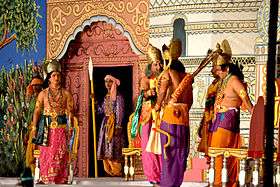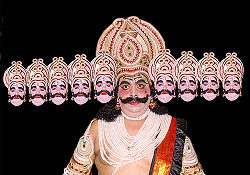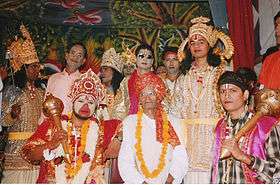Ramlila

Ramlila (Rāmlīlā) (literally 'Rama’s lila or play') is a dramatic folk re-enactment of the life of Rama, ending up in ten-day battle between Rama and Ravana, as described in the Hindu religious epic, the Ramayana.[1] A tradition that originates from the Indian subcontinent, the play is staged annually often over ten or more successive nights, during the auspicious period of 'Sharad Navratras', which marks the commencement of the Autumn festive period, starting with the Dussehra festival. Usually the performances are timed to culminate on the festival of Vijayadashami day, that commemorates the victory of Rama over demon king Ravana, when the actors are taken out in a procession through the city, leading up to a mela ground or town square, where the enactment of the final battle takes place, before giant effigies of Ravana, his brother Kumbhakaran and son Meghanath are set fire, and coronation or abhisheka of Rama at Ayodhya takes place, marking the culmination of festivities and restoration of the divine order.[2]
Rama is the 7th incarnation of Vishnu and central figure of the Ramayana. The Ramayana is based on the life, times and values of Lord Rama. Lord Rama is called the Maryada Purushottam or 'The best among the dignified'. The story of Lord Rama and his comrades is so popular in India that it has actually amalgamated the psyche of the Indian mainstream irrespective of their religion. The very story of Ramayana injects ethics to the Indian mainstream.
Most Ramlilas in North India are based on the 16th century Avadhi version of Ramayana, Ramcharitmanas, written by Gosvami Tulsidas entirely in verse, thus used as dialogues in most traditional versions, where open-air productions are staged by local Ramlila committees, 'Samitis', and funded entirely by the local population, the audience.[3] It is close to the similar form of folk theatre, Rasa lila, which depicts the life of Krishna, popular in Uttar Pradesh, especially Braja regions of Mathura, Vrindavan, and amongst followers of Gaudiya Vaishnavism and Vaishnavism in Manipur, with some similarity with Pandavlila of Garhwal, based on life of Pandavas of Mahabharat and Yakshagana of Karnataka, based on various epic and puranas.[4]
Ramlila has received considerable global attention, especially due to its diverse representation throughout the globe, especially amongst the Indian diaspora community, and regions where Hinduism has spread over the centuries, like Africa and several South East Asian countries. UNESCO proclaimed the tradition of Ramlila a Masterpiece of the Oral and Intangible Heritage of Humanity in 2005.[5] Subsequently, Govt. of India and IGNCA produced a two-hour documentary, titled "Ramlila - The traditional performance of Ramayana" for UNESCO, on 'Ramnagar Ramlila', and Ramlila traditions of Avadh, Braj and Madhubani, and that of Ayodhya, which assimilates elements of all three.[6] Another unique Ramlila, is being staged since 1972, at Bakshi Ka Talab, about 20 km from Lucknow, where lead characters like Rama, Lakshman and Hanuman are played by Muslim youths, a clear departure in a region known for communal flare-ups; this four-day Ram Lila starts on the day of Dusshera day, and has also been adapted into a Radio play, 'Us Gaon ki Ram Lila', by Lucknow All India Radio, which won the Communal Harmony Award in 2000.[7]
History

Historically it is believed that first Ramlila shows were staged by Megha Bhagat, one of the disciples of Tulsidas, the author of Ramacharitamanas in about 1625 AD, though there are some evidence of its existence in some form before the creation of this version as well. Some scholars believe its first appearance somewhere between 1200 and 1500 AD. Later during in the time of Mughal emperor Akbar, according to some, Akbar is said to have watched a performance. Krishna Das Kaviraj mentions in his 16th century hagiography of saint Chaitanya Mahaprabhu (1486–1533), Chaitanya Charitamrita, that once he got carried away while performing the character of Hanuman at a play in Puri, thus proving the existence of Ramayana plays, before the Ramcharitamanas appeared.[4] Though it would safe to conclude that its implosion into the Hindi heartland, happened only after Tulsidas created his version in people's language of the time, the Avadhi, unlike the original written by Valmiki, in Sanskrit, the language only spoken by Brahmins by then, which excluded much of masses from experiencing the inspirational saga, which is essentially the victory of good over evil.[8]
Styles of Ramlila
Today, several regions have developed their distinctive form of Ramlila, Uttar Pradesh itself has numerous variants of presentation styles, most prominent among them is that of Ramnagar, Varanasi, staged over multiple venue, the pantomime style is visible in jhankis or tableaux pageants as seem in Ramlila of Varanasi, where colourful Jhankis and pageants depicting scenes from the life of Lord Rama are taken out through the city.[9] According to a 2008 UNESCO report, the most representative Ramlilas are those of Ayodhya, Ramnagar and Varanasi, Vrindavan, Almora, Satna and Madhubani.[5]
The Almora or Kumaon style was set in the musical rendering of thekatha based on the theatrical style developed by Uday Shankar during his stay in Almora, it was carried on forward by Mohan Upreti and Brijendra Lal Sah.

Next is the operatic style incorporates elements of folk theatre elements generously, while the traditional style remains, where the couplets of Ramacharitmanas not only act as dialogues, but also as chorus as well, and lastly there is the Ramlila staged by professional troupes called "mandalis".[10] Many urban Ramilias now have dialogues written in Khadi Boli or in local dialects, but the treatment remains melodramatic as always to achieve maximum impact amidst an audience that knows the story by heart, but watches the enactment nevertheless for religious fervour and also for its spectacle value, making Ramlila an important event in the religious as well as social calendar of not only in small town and villages but also many big cities. Just other folk theatre form of India, like Jatra of Bengal, topic themes are often interwoven in the script to had relevance and sometimes humour is used to offer a critic or commentary over current happenings.
A unique staging of Ramlila, takes place at Chitrakoot, over five days every year during the last week of February, beginning from the Maha Shivratri day, here the episode of Bharat-Milap is of prime importance, and is watched by eager devotees.[11] The Ram Barat of Agra is another interesting tradition connected with Ramlila, where in during the three festivities, a marriage procession of Rama is taken through various localities of the city.
Delhi holds many prominent Ramlilas across the city, including the oldest one on the Ramlila Grounds, outside the historic Red Fort, it was started in times of Mughal emperor Bahadur Shah Zafar,[12] and in 2004, for the first time, Ramlila celebrations organised by Luv-Kush Ramlila Committee were telecast to over 100 countries, telecast on SADHNA TV.[13]
Jaisinghpur has been also known as the first place in Kangra or perhaps in entire Himachal for staging Ramlila festival. Ramlila of Jaisinghpur started some 90 years ago and almost all the actors were Brahmin, mainly from Awasthi community. Pandit Balkishan Awasthi, a native of Jaisinghpur who lived in Mumbai for his work and also associated with theatre there, have brought all the Drama items required for Ramlila from Mumbai and started Ramlila festival single handedly at Jaisinghpur. He used to play the role of Ravana in the Ramlila and become very popular because of his dialogue delivery in strong deep voice and due to his tall, handsome personality. The uniqueness of the Ramlila was the Sanskrit language used at that time, most Ramlilas in North India are based on the 16th century Avadhi version of Ramayana, Ramcharitmanas, written by Gosvami Tulsidas entirely in verse, thus used as dialogues in most traditional versions.
Ramlila at Ramnagar, Varanasi
The tradition of staging the Ramlila at Ramnagar, Varanasi, which lies across the Ganges river from the Hindu pilgrimage city of Varanasi, was started in ca 1830 by Maharaja Udit Narayan Singh, Kashi Naresh with the help of Pandit Laxmi Narayan Pandey's family (present vyas ji of the Ramlila of Ramnagar).[14][15] It rose in popularity during the reign of his successor Maharaj Isvari Prasad Singh, and received continued patronage from the subsequent Kings of the Royal House of Benares to create a participatory environmental theatre (Site-specific theatre) on a grand scale, where attendance ranges from few thousands to 100,000 for others.[16] The Ramlila is a cycle of plays which recounts the epic story of Lord Rama, as told in Ramcharitmanas, the version of the Ramayana penned by Tulsidas. The plays sponsored by the Maharaja, are performed in Ramnagar every evening for 31 days.[15]
Though several local legends exist regarding the beginning of this Ramlila, including one of which suggests that it was first staged at a nearby village, Chota Mirzapur as the one at Varanasi was disrupted due to the floods in the Ganges, from where it evolved to the present Ramlila, which is by far the most traditional rendition of the Ramayana, and has been a subject of study by scholars from all over the world for many decades now.[17]

The Ramnagar Ramlila is held over 31 days instead of usual 10, and is known for its lavish sets, dialogues and visual spectacle. Here permanent structures have been built and several temporary structure are also added, which serve as sets, to represent locations like Ashok Vatika, Janakpuri, Panchavati, Lanka etc., during the performance. Hence the entire city turn into a giant open-air set, and audience moves along with the performers with every episode, to the next locale. Preparations begin, weeks before its commencement, even the audition process is traditionally attended to by the Maharaja, where Svarupas, literally divine embodiment, the various characters of the Ramayana, are chosen from amongst local actors. Important roles are often inherited by families, for example, the role of Ravana was held by same family from 1835 to 1990, and roles of Hanuman, Jatayu, and Janaka traditionally belong to one Vyasa family.[18] When the Dussehra festivities are inaugurated with a colourful pageant Kashi Naresh rides an elephant at the head of the procession.[15] Then, resplendent in silk and brocade, he inaugurates the month-long folk theatre of Ramlila at Ramnagar.[15] During the period, hundreds of sadhus called 'Ramayanis' descend into the town to watch and recite the Ramcharitmanas text. Many an audience carry a copy of the Ramacharit Manas, simply called Manas, and follow stanza after stanza, after the characters delivering their dialogue.[19][20]
During the course of the performance, there is a double transformation of the space within the city, as it first transforms from a city to theatre and then to mythic geography, as the scale of the performance is gradually increased to mythic proportions, coming down only in the end, when Rama finally returns home, this is when the Raja himself becomes part of the theatre thereby incorporating local element into the story itself. In the end, as the swarups, actors depart, they take off their garlands and offer it to Royal family members and give darshan to audience, after the performance one last time.[21] At the end of each episode, lila, an aarti is performed, chants of 'Har Har Mahadev' or 'Bolo! Raja Ramchandra ki Jai!' resound in the air, as the audience join in. Thereafter, a jhanki, literally a peep or glimpse, tableaux of frozen iconic moments from the 'Manas', is presented, which not only distill and crystallize the message of the story for the audience, but is also appreciated for its spectacular effect.[21]
On the last day the festivities reach a crescendo as Rama vanquishes the demon king Ravana.[15] Over a million pilgrims arrive annually for the vast processions and performances organized by Kashi Naresh.[22]
Format

Traditionally organized in a makeshift open-air theatre at night, it is usually staged by amateur actors drawn from the same social grouping as the audience. There is often a singer (occasionally a priest) in the sidelines who recites relevant verses from the Ramayana during scene-changes or at moments of dramatic tension. These recitations and the narrative of the play are usually based on Ramacharitamanas, Gosvami Tulsidas' version of the Ramayana, in the Awadhi language, written in the 16th century. The dialog is improvised, and often responsive to audience reactions. Dhol drummers and other musicians participate. The atmosphere is usually festive and free, with the audience whistling and commenting as the story proceeds.
In many rural areas, traditional venues for Ramlila have developed over the centuries, and hundreds of people will often make the trip nightly to attend the play. Surrounding areas temporarily transform into bazaars to cater to the audience. Depending on the region, interspersed breaks in the play can become impromptu talent shows for local society, and a de facto competition takes place between neighbouring Ram lilas, each vying to stage a more lavish production. Though the play itself is thematically religious, this social aspect often draws in people from non-Hindu segments of the community as well. Performance costs are usually financed by fundraising in the community, often by self-organized Ramlila Committees.
Geographic spread
Over the centuries, Ramlila has evolved into a highly venerated art form, and has travelled to far corners of the globe, through Indian diaspora, not as acts of "cultural recovery", rather as fresh expressions of a persistent faith. Today, Ramalila is staged in most countries that with immigrant Hindu populations from the Indian subcontinent, including that from India, Nepal and Pakistan. Outside the Indian subcontinent, this includes Fiji, Mauritius, South Africa, Canada, Guyana, Suriname, Trinidad and Tobago, Great Britain, The Netherlands, the United States, and Australia. Some Asian cultures have similar drama traditions based on the Ramayana, for instance the Phra Lak Phra Lam (Lak and Lam are the Laotian names for Lakshman and Ram, respectively) folkplay of Laos and northeastern Thailand.
References
- ↑ Ramlila Britannica.com.
- ↑ Ramlila Pop Culture India!: Media, Arts, and Lifestyle, by Asha Kasbekar. Published by ABC-CLIO, 2006. ISBN 1-85109-636-1. Page 42.
- ↑ Ramlila: Spectator-participants in God's life indiayogi.com
- 1 2 The Epics in Bhakti Tradition The Intimate Other: Love Divine in Indic Religions, by Anna S. King, J. L. Brockington. Published by Orient Blackswan, 2005. ISBN 81-250-2801-3. Page 48.
- 1 2 Ramlila - the Traditional Performance of the Ramayana UNESCO.
- ↑ Ramlila - The traditional performance of Ramayana - Part I & II Indira Gandhi National Centre for the Arts.
- ↑ Where Muslims keep Ram Lila alive Sangita Bakaya in Lucknow, Rediff.com, October 5, 2008.
- ↑ Ramlila South Asian Folklore: An Encyclopedia : Afghanistan, Bangladesh, India, Nepal, Pakistan, Sri Lanka, by Peter J. Claus, Sarah Diamond, Margaret Ann Mills. Published by Taylor & Francis, 2003. ISBN 0-415-93919-4. Page 507 .
- ↑ Ramlila Department of Tourism, Government of UP, Uttar Pradesh.
- ↑ Ramlila in Uttar Pradesh www.bharatonline.com.
- ↑ Festivals of India - Ramlila www.aryabhatt.com.
- ↑ Save this Ramlila The Hindu, Monday, October 6, 2008.
- ↑ Live Ramlila telecast in 100 countries Sify.com, Thursday, October 14, 2004.
- ↑ Ramleela - Ramnagar Varanasi Official website.
- 1 2 3 4 5 Mitra, Swati (2002). Good Earth Varanasi city guide. Eicher Goodearth Limited. p. 216. ISBN 978-81-87780-04-5.
- ↑ A Maharajah´s Festival for Body and Soul New York Times, Monday, March 30, 2009.
- ↑ "What's Taking Place: Neighborhood Ramlilas in Banaras" by Thomas Parkhill Living Banaras: Hindu Religion in Cultural Context, Bradley R. Hertel and Cynthia Ann Humes eds. Albany: SUNY Press, 1993. St. Thomas University.
- ↑ Ramlila: The Performance in Ramnagar University of North Texas.
- ↑ Performative Circumstances, from the Avant Garde to Ramlila: from the avant garde to Ramlila, by Richard Schechner. Published by Seagull Books, 1983. ISBN 0-86132-046-8. Page 238.
- ↑ Ramlila of Varanasi bharatonline.com.
- 1 2 Ramlila of Ramanagar The future of ritual: writings on culture and performance, by Richard Schechner. Published by Routledge, 1993. ISBN 0-415-04689-0. Page 169.
- ↑ Banham, Martin (1995). The Cambridge Guide to Theatre (second ed.). Cambridge University Press. p. 1247. ISBN 978-0-521-43437-9.
- Actors, Pilgrims, Kings And Gods: The Ramlila of Ramnagar, by Anuradha Kapur, Seagull, 2006. ISBN 1-905422-20-2.
- "Peasants in the Pacific: A Study of Fiji Indian Rural Society," Adrian C. Mayer, Routledge & Kegan Paul, London, 1973.
- "The Cambridge Guide to Asian Theatre," James R. Brandon, Cambridge University Press, 1997.
External links
| Wikimedia Commons has media related to Ramlila. |
- Ramleela of Greater Noida by Adarsh Kala Sangam, Greater Noida
- Ramlila at Ramnagar Fort Varanasi-find all info
- Ram leela-Life of lord Ram- IshtaDevata
.jpg)